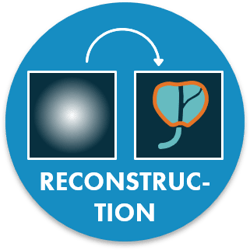Last year, RSNA included over 130 AI companies showcasing their radiology software, and this was only the tip of the iceberg as many companies are not yet ready for show-time. The vast majority of these companies focuses on image analysis applications - they detect lesions, measure a volume or provide an image-based risk score. However, interestingly, there is a wide range of opportunities to improve the image-based diagnostic workflow even before the images are ready for reporting and potentially even before reconstruction takes place . Specifically in the context of prostate MRI, what are the various value-adds that AI can offer? How can AI be leveraged to speed improve accuracy and efficiency of the diagnostic pathway? Let’s look at this question from a few angles - walking us gently through the imaging process from pre-exam preparation to scan acquisition, image reconstruction and reading preparation.
Improving the pre-imaging process with AI in prostate MRI
 The prostate cancer diagnostic pathway usually starts with a patient visiting a GP who runs several tests like a prostate specific antigen (PSA) test of the blood and a digital rectal exam (DRE), and the GP refers the patient to a urologist if there is a suspicion of prostate cancer. Since 2019 many health systems globally have introduced new guidelines that recommend an MRI scan as a next step, before a prostate biopsy is acquired. The image-based part of the diagnostic process consists of many steps. Even before the patient enters the scanner, a wide range of activities occur, such as ordering the prostate MRI exam, getting the exam on the schedule, and preparing and supporting the patient. What can AI do to facilitate a smooth and efficient process?
The prostate cancer diagnostic pathway usually starts with a patient visiting a GP who runs several tests like a prostate specific antigen (PSA) test of the blood and a digital rectal exam (DRE), and the GP refers the patient to a urologist if there is a suspicion of prostate cancer. Since 2019 many health systems globally have introduced new guidelines that recommend an MRI scan as a next step, before a prostate biopsy is acquired. The image-based part of the diagnostic process consists of many steps. Even before the patient enters the scanner, a wide range of activities occur, such as ordering the prostate MRI exam, getting the exam on the schedule, and preparing and supporting the patient. What can AI do to facilitate a smooth and efficient process?
Personalize the prostate MRI pathway with AI powered risk stratification
If a PSA test raises enough suspicion for further exams, a urologist can request an MRI (which is usually a click of a button exercise). This is easy, sure, but it also ignores the opportunity to optimize the imaging request. What if we could implement an AI-based risk model that determines the best next step in the diagnostic process which offers the most diagnostic value? This AI model can use all available patient data, such as PSA and DRE test results, age, patient history, family history, co-morbidities to recommend an abbreviated MRI protocol for one patient, an extended protocol for the next and perhaps non-imaging tests (instead of MRI) such as Stockholm 3 for yet another patient. This avoids a one-size-fits-all approach and has the potential to make the entire diagnostic pathway significantly more accurate and effective.
I can already hear some physicians say that they are already taking this personalized approach and that they do not need AI for this. Here is the caveat: AI can base its assessment on much larger patient databases. A good physician has probably seen hundreds perhaps thousands of cases and most likely she has read-up on the latest literature that draws conclusions on thousands more. AI has the power to base decisions on orders of magnitude more information and arrive more consistently to the right conclusion.

Optimizing prostate MRI acquisition using AI
 The patient is in the scanner, and the prostate MRI protocol has been selected and started. Everything is ready to acquire the requested scans. What can AI bring us to ensure we make the most of the time used for acquisition?
The patient is in the scanner, and the prostate MRI protocol has been selected and started. Everything is ready to acquire the requested scans. What can AI bring us to ensure we make the most of the time used for acquisition?
Upgrade old hardware with new AI
An MRI machine contains a lot of hardware, including the B0-field magnet, gradient coils, and radiofrequency coils, which are all produced with the greatest of care and precision. However, it is a known fact that imperfections remain, causing distortions in the magnetic field. These small deficiencies (sometimes not so small) hamper image quality. One option is to keep optimizing the hardware, which is a route taken by many manufacturers that create stronger magnetic fields with more stable gradients. However, another option lies in the development of smart software for optimization of, for example, the different gradient fields. AI can play an interesting role in this context. Imagine a scanner-specific algorithm that is trained to correct the shortcomings of that machine. Instead of buying state-of-the-art MRI scanners, it might be a much more efficient approach to invest in AI-based finetuning of the acquisition and reconstruction protocols improving signal-to-noise ratio and reducing scanner artifacts.
Include an automated quality check
Image quality assessment is another application of AI during scanning that is worth consideration. A lot of time is wasted because image quality is not up to clinical standards causing hinderance of the radiologists reading of the scan. Hence, a repeat scan cannot be avoided. This does not only cost precious scanner and physician time, but the diagnosis is also delayed, the patient needs to revisit the hospital, and costs are often not eligible to expense a second time. In other words, this is a scenario that every hospital wants to avoid. The good news is that AI can also provide a solution to this problem. While a patient is still on the table an AI algorithm could alert the scanner operator of susceptibility artifacts caused by air in the bowels or movement artifacts. If the image is not sufficient for clinical assessment, the exam can be (partially) restarted and better images can be obtained - avoiding the hassle of repeating the full exam on another day.
Supercharge scanning protocol with AI
When observing a radiologist at work, it is clear that in many cases not all sequences are used in making a decision on a next step. This is especially true for normal cases where often one or more acquired sequences are not used. For example, in prostate MRI, only cases that show an intermediate risk (PI-RADS III) on the diffusion weighted sequence will require (according to the protocols) a contrast series to provide additional information. It would be very helpful if the scanning protocol starts with a minimum set of sequences and only extends the protocol to a contrast sequence when situations such as the one above are detected.
Another way to optimize the scanning protocol is by accelerating the scan acquisition itself. AI algorithms can support faster acquisitions by, for instance, filling k-space in an optimized way. An example of such a technique is compressed sensing, where you only acquire part of k-space and, with the use of deep learning-based reconstruction, generate an image of non-inferior quality to the traditional acquisition.
Enhancing prostate MRI image reconstruction generation using AI
 The raw data has been acquired; K-space has been filled. It is ready to be turned into an image through Fourier transformations. How can AI help realize better image quality?
The raw data has been acquired; K-space has been filled. It is ready to be turned into an image through Fourier transformations. How can AI help realize better image quality?
Address incomplete k-space filling
As mentioned before, k-space can be acquired partially on purpose, after which AI algorithms can reconstruct an image that is up to clinical standards. However, it can also occur that k-space has not been fully filled due to complications that occurred during acquisition. Also in this case, AI software may be able to work its magic and provide an output image of sufficient quality for a radiology reading.
Give k-space that little bit of extra
Even when k-space is fully filled, we can still apply an AI algorithm that optimizes the image reconstruction. Different types of artefacts can distort the image. A well-trained AI algorithm can learn how to correct for these artefacts while creating the final image from k-space data - an optimization step that seems a waste not to implement!1
Giving the reading process a heads start
 As radiologists working in a telehealth setting will attest, series descriptions, study descriptions and other DICOM headers are often very messy leading to a lot of delays in finding that high b-value, axial scan and ADC map in the list of 20+ sequences. AI can make life so much easier for the radiologist by automatically selecting the right sequences and creating a preferred hanging for the radiologist. This seemingly easy problem proves difficult to solve if you work with scans coming from different scanner vendors in different language settings etc. etc. In this case, simple filters will not be robust enough. Hence, we need another solution. If AI-algorithms would be able to recognize specific series, not based on their DICOM headers, but on image characteristics, the software could automatically place the T2 on the top left, the DWI on the bottom right, etc. This would enable automated hanging creation, without a DICOM header dependency. Combining this approach with an algorithm that recognizes who logged in to the system, would even allow the computer to select your personal favorite hanging protocol each time the prostate MRI viewer is opened.
As radiologists working in a telehealth setting will attest, series descriptions, study descriptions and other DICOM headers are often very messy leading to a lot of delays in finding that high b-value, axial scan and ADC map in the list of 20+ sequences. AI can make life so much easier for the radiologist by automatically selecting the right sequences and creating a preferred hanging for the radiologist. This seemingly easy problem proves difficult to solve if you work with scans coming from different scanner vendors in different language settings etc. etc. In this case, simple filters will not be robust enough. Hence, we need another solution. If AI-algorithms would be able to recognize specific series, not based on their DICOM headers, but on image characteristics, the software could automatically place the T2 on the top left, the DWI on the bottom right, etc. This would enable automated hanging creation, without a DICOM header dependency. Combining this approach with an algorithm that recognizes who logged in to the system, would even allow the computer to select your personal favorite hanging protocol each time the prostate MRI viewer is opened.
In conclusion
AI offers many opportunities to improve the MRI imaging process for prostate cancer patients. Whether it is before the actual MRI exam takes place, while the patient is in the scanner, or during reconstruction, we have looked at a range of promising options. Even then, we did not touch on many of the things AI can offer in the context of reading prep, for example, through AI support for image reading, automated report creation, or by diving into the world of image analysis and providing valuable input for radiologists to support their diagnosis process. AI will supercharge the future of radiology.
Bibliography
- Lin, D. J., Johnson, P. M., Knoll, F. & Lui, Y. W. Artificial Intelligence for MR Image Reconstruction: An Overview for Clinicians. 1–14 (2020). doi:10.1002/jmri.27078
